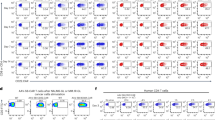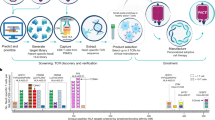Abstract
Adoptive immunotherapy with T lymphocytes expressing transgenic T-cell receptors (TCRs) has shown significant clinical efficacy in various malignant diseases. However, concurrent expression of endogenous and transgenic TCRs in one and the same T cell may impair efficacy and cause safety problems owing to mispairings. The most elegant approach to address these issues is the complete shutoff of the endogenous receptor chains by genome editing. To this end, we designed TCR-α and TCR-β-specific pairs of transcription activator-like effector nucleases (TALENs). TALENs were delivered into T cells using an optimized messenger RNA-electroporation protocol. Based thereon, we obtained precise and highly efficient knockout (KO) in Jurkat (TCR-α: 59.7±4.0%, TCR-β: 37.4±7.3%) as well as primary T cells (TCR-α: 58.0±15.0%, TCR-β: 41.0±17.6%). Moreover, a successive KO strategy for the endogenous TCR chains combined with subsequent transduction of the respective chains of an Influenza virus-specific model TCR led to complete reprogramming of T cells with strongly improved expression and functionality of transgenic TCRs. In conclusion, we have developed novel means for the efficient genome editing in primary T lymphocytes.
This is a preview of subscription content, access via your institution
Access options
Subscribe to this journal
Receive 12 print issues and online access
$259.00 per year
only $21.58 per issue
Buy this article
- Purchase on Springer Link
- Instant access to full article PDF
Prices may be subject to local taxes which are calculated during checkout







Similar content being viewed by others
Abbreviations
- TCR:
-
T-cell receptor
- Flu:
-
Influenza
- Flu-M:
-
Influenza matrix protein
- TALEN:
-
TAL effector nuclease
References
Gustafsson Å, Levitsky V, Zou J, Frisan T, Dalianis T, Ljungman P et al. Epstein-Barr virus (EBV) load in bone marrow transplant recipients at risk to develop posttransplant lymphoproliferative disease: prophylactic infusion of EBV-specific cytotoxic T cells. Blood 2000; 95: 807–814.
Peggs KS, Verfuerth S, Pizzey A, Khan N, Guiver M, Moss PA et al. Adoptive cellular therapy for early cytomegalovirus infection after allogeneic stem-cell transplantation with virus-specific T-cell lines. Lancet 2003; 362: 1375–1377.
Rosenberg SA, Restifo NP, Yang JC, Morgan RA, Dudley ME, Mark E . Adoptive cell transfer: a clinical path to effective cancer immunotherapy. Nat Rev Cancer 2008; 8: 299–308.
Gross G, Waks T, Eshhar Z . Expression of immunoglobulin-T-cell receptor chimeric molecules as functional receptors with antibody-type specificity. Proc Natl Acad Sci USA 1989; 86: 10024–10028.
Morgan RA, Dudley ME, Wunderlich JR, Hughes MS, Yang JC, Sherry RM et al. Cancer regression in patients after transfer of genetically engineered lymphocytes. Science 2006; 314: 126–129.
Robbins PF, Morgan RA, Feldman SA, Yang JC, Sherry RM, Dudley ME et al. Tumor regression in patients with metastatic synovial cell sarcoma and melanoma using genetically engineered lymphocytes reactive with NY-ESO-1. J Clin Oncol 2011; 29: 917–924.
Porter DL, Levine BL, Kalos M, Bagg A, June CH . Chimeric antigen receptor-modified T cells in chronic lymphoid leukemia. N Engl J Med 2011; 365: 725–733.
Grupp SA, Kalos M, Barrett D, Aplenc R, Porter DL, Rheingold SR et al. Chimeric antigen receptor-modified T cells for acute lymphoid leukemia. N Engl J Med 2013; 368: 1509–1518.
Kalos M . Muscle CARs and TcRs: turbo-charged technologies for the (T cell) masses. Cancer Immunol Immunother 2012; 61: 127–135.
Stauss HJ, Morris EC . Immunotherapy with gene-modified T cells: limiting side effects provides new challenges. Gene Therapy 2013; 20: 1029–1032.
Berdien B, Reinhard H, Meyer S, Spöck S, Kröger N, Atanackovic D et al. Influenza virus-specific TCR-transduced T cells as a model for adoptive immunotherapy. Hum Vaccin Immunother 2013; 9: 1205–1216.
Provasi E, Genovese P, Lombardo A, Magnani Z, Liu P-Q, Reik A et al. Editing T cell specificity towards leukemia by zinc finger nucleases and lentiviral gene transfer. Nat Med 2012; 18: 807–815.
Heemskerk MHM, Hagedoorn RS, van der Hoorn MAWG, van der Veken LT, Hoogeboom M, Kester MGD et al. Efficiency of T-cell receptor expression in dual-specific T cells is controlled by the intrinsic qualities of the TCR chains within the TCR-CD3 complex. Blood 2007; 109: 235–243.
Bendle GM, Linnemann C, Hooijkaas AI, Bies L, de Witte MA, Jorritsma A et al. Lethal graft-versus-host disease in mouse models of T cell receptor gene therapy. Nat Med 2010; 16: 565–570.
Cohen CJ, Zhao Y, Zheng Z, Rosenberg SA, Morgan RA . Enhanced antitumor activity of murine-human hybrid T-cell receptor (TCR) in human lymphocytes is associated with improved pairing and TCR/CD3 stability. Cancer Res 2006; 66: 8878–8886.
Bialer G, Horovitz-Fried M, Ya’acobi S, Morgan RA, Cohen CJ . Selected murine residues endow human TCR with enhanced tumor recognition. J Immunol 2010; 184: 6232–6241.
Sommermeyer D, Uckert W . Minimal amino acid exchange in human TCR constant regions fosters improved function of TCR gene-modified T cells. J Immunol 2010; 184: 6223–6231.
Cohen CJ, Li YF, El-Gamil M, Robbins PF, Rosenberg SA, Morgan RA . Enhanced antitumor activity of T cells engineered to express T-cell receptors with a second disulfide bond. Cancer Res 2007; 67: 3898–3903.
Kuball J, Dossett ML, Wolfl M, Ho WY, Voss R-H, Fowler C et al. Facilitating matched pairing and expression of TCR chains introduced into human T cells. Blood 2007; 109: 2331–2338.
Scholten KBJ, Kramer D, Kueter EWM, Graf M, Schoedl T, Meijer CJLM et al. Codon modification of T cell receptors allows enhanced functional expression in transgenic human T cells. Clin Immunol 2006; 119: 135–145.
Zhang L, Morgan RA . Genetic engineering with T cell receptors. Adv Drug Deliv Rev 2012; 64: 756–762.
Okamoto S, Mineno J, Ikeda H, Fujiwara H, Yasukawa M, Shiku H et al. Improved expression and reactivity of transduced tumor-specific TCRs in human lymphocytes by specific silencing of endogenous TCR. Cancer Res 2009; 69: 9003–9011.
Moscou MJ, Bogdanove AJ . A Simple Cipher Governs DNA Recognition by TAL Effectors. Science 2009; 326: 1501.
Deng D, Yan C, Pan X, Mahfouz M, Wang J, Zhu J-K et al. Structural basis for sequence-specific recognition of DNA by TAL effectors. Science 2012; 335: 720–723.
Doyle EL, Booher NJ, Standage DS, Voytas DF, Brendel VP, Vandyk JK et al. TAL effector-nucleotide targeter (TALE-NT) 2.0: tools for TAL effector design and target prediction. Nucleic Acids Res 2012; 40: W117–W122.
Cermak T, Doyle EL, Christian M, Wang L, Zhang Y, Schmidt C et al. Efficient design and assembly of custom TALEN and other TAL effector-based constructs for DNA targeting. Nucleic Acids Res 2011; 39: e82.
Weber K, Bartsch U, Stocking C, Fehse B . A multicolor panel of novel lentiviral ‘gene ontology’ (LeGO) vectors for functional gene analysis. Mol Ther 2008; 16: 698–706.
Wang Z, Troilo PJ, Wang X, Griffiths TG, Pacchione SJ, Barnum AB et al. Detection of integration of plasmid DNA into host genomic DNA following intramuscular injection and electroporation. Gene Therapy 2004; 11: 711–721.
Van Loenen MM, de Boer R, Amir AL, Hagedoorn RS, Volbeda GL, Willemze R et al. Mixed T cell receptor dimers harbor potentially harmful neoreactivity. Proc Natl Acad Sci USA 2010; 107: 10972–10977.
Sung YH, Baek I-J, Kim DH, Jeon J, Lee J, Lee K et al. Knockout mice created by TALEN-mediated gene targeting. Nat Biotechnol 2013; 31: 23–24.
Huang X, Haley K, Wong M, Guo H, Lu C, Wilber A et al. Unexpectedly high copy number of random integration but low frequency of persistent expression of the Sleeping Beauty transposase after trans delivery in primary human T cells. Hum Gene Ther 2010; 21: 1577–1590.
Stephen SL, Montini E, Sivanandam VG, Al-Dhalimy M, Kestler HA, Finegold M et al. Chromosomal integration of adenoviral vector DNA in vivo. J Virol 2010; 84: 9987–9994.
Miller DG, Rutledge EA, Russell DW . Chromosomal effects of adeno-associated virus vector integration. Nat Genet 2002; 30: 147–148.
Mátrai J, Cantore A, Bartholomae CC, Annoni A, Wang W, Acosta-Sanchez A et al. Hepatocyte-targeted expression by integrase-defective lentiviral vectors induces antigen-specific tolerance in mice with low genotoxic risk. Hepatology 2011; 53: 1696–1707.
Riet T, Holzinger A, Dörrie J, Schaft N, Schuler G, Abken H . Nonviral RNA transfection to transiently modify T cells with chimeric antigen receptors for adoptive therapy. Methods Mol Biol 2013; 969: 187–201.
Gabriel R, Lombardo A, Arens A, Miller JC, Genovese P, Kaeppel C et al. An unbiased genome-wide analysis of zinc-finger nuclease specificity. Nat Biotechnol 2011; 29: 816–823.
Fu Y, Foden JA, Khayter C, Maeder ML, Reyon D, Joung JK et al. High-frequency off-target mutagenesis induced by CRISPR-Cas nucleases in human cells. Nat Biotechnol 2013; 31: 822–826.
Almåsbak H, Rian E, Hoel HJ, Pulè M, Wälchli S, Kvalheim G et al. Transiently redirected T cells for adoptive transfer. Cytotherapy 2011; 13: 629–640.
Newrzela S, Cornils K, Li Z, Baum C, Brugman MH, Hartmann M et al. Resistance of mature T cells to oncogene transformation. Blood 2008; 112: 2278–2286.
Scholler J, Brady TL, Binder-Scholl G, Hwang WT, Plesa G, Hege KM et al. Decade-long safety and function of retroviral-modified chimeric antigen receptor T cells. Sci Transl Med 2012; 4: 132ra153.
Fehse B, Schade UM, Li Z, Uhde A, Koch S, Goller B et al. Highly-efficient gene transfer with retroviral vectors into human T lymphocytes on fibronectin. Br J Haematol 1998; 102: 566–574.
Sanjana NE, Cong L, Zhou Y, Cunniff MM, Feng G, Zhang F . A transcription activator-like effector toolbox for genome engineering. Nat Protoc 2012; 7: 171–192.
Weber K, Mock U, Petrowitz B, Bartsch U, Fehse B . Lentiviral gene ontology (LeGO) vectors equipped with novel drug-selectable fluorescent proteins: new building blocks for cell marking and multi-gene analysis. Gene Therapy 2010; 17: 511–520.
Janeway CA, Travers P, Walport M, Shlomchik MJ . Immunobiology: The Immune System in Health and Disease. Garland Science: New York, 2004.
Acknowledgements
This work has been part of the PhD thesis of BB at the MIN faculty of the University of Hamburg. We wish to thank Johannes Polke, Tanja Sonntag, Tim Aranyossy and the FACS Core Facility of the University Medical Center Hamburg-Eppendorf for expert technical assistance and the Department of Transfusion Medicine of the UMC Hamburg-Eppendorf for kind help. Our work was supported by a grant of the Deutsche Krebshilfe (to BF and DA) and, in part, the SFB841/Z2 and a post-doc grant to UM within the Forschungsförderung Medizin (FFM) program of the Medical faculty of the UMC Hamburg-Eppendorf.
Author contributions
BB designed and performed experiments; UM helped with design and application of TALENs; DA with T-cell assays; BF designed the study and wrote the manuscript. All authors have read the manuscript and confirmed their authorship.
Author information
Authors and Affiliations
Corresponding author
Ethics declarations
Competing interests
The authors declare no conflict of Interest.
Additional information
Supplementary Information accompanies this paper on Gene Therapy website
Supplementary information
Rights and permissions
About this article
Cite this article
Berdien, B., Mock, U., Atanackovic, D. et al. TALEN-mediated editing of endogenous T-cell receptors facilitates efficient reprogramming of T lymphocytes by lentiviral gene transfer. Gene Ther 21, 539–548 (2014). https://doi.org/10.1038/gt.2014.26
Received:
Revised:
Accepted:
Published:
Issue Date:
DOI: https://doi.org/10.1038/gt.2014.26
This article is cited by
-
T cell receptor therapeutics: immunological targeting of the intracellular cancer proteome
Nature Reviews Drug Discovery (2023)
-
TCR engineered T cells for solid tumor immunotherapy
Experimental Hematology & Oncology (2022)
-
CRISPR/Cas9-mediated knockout of clinically relevant alloantigenes in human primary T cells
BMC Biotechnology (2021)
-
CRISPR/Cas9 revitalizes adoptive T-cell therapy for cancer immunotherapy
Journal of Experimental & Clinical Cancer Research (2021)
-
T-cell receptor-based therapy: an innovative therapeutic approach for solid tumors
Journal of Hematology & Oncology (2021)



